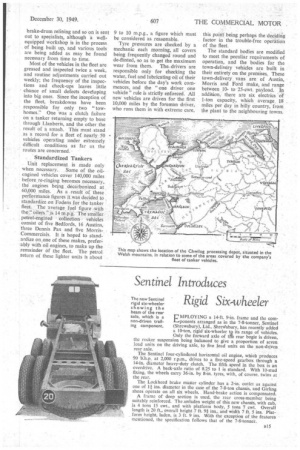Over the Hills and Far Away—with MILK T UCKED away in
Page 48

Page 49

If you've noticed an error in this article please click here to report it so we can fix it.
a fold of the Welsh mountains, alongside a swift-flowing brook. I suddenly came across a factory, its entrance being flanked by a granite bridge. Being inquisitive, my interest was further stimulated when, in the factory yard, I could see several smart brown-and-cream-painted lorries in various stages of loading and unloading. The sign-writing on the wall of the solidly built stone building revealed that here was the Chwilog processing plant of the South Caernarvon Creameries, Ltd.
Mr. D. Jones, the plant manager and transport engineer, to whom I was introduced, told me that the creamery was started as a co-operative effort by some of the leading farmers in the Lleyn Peninsula some 15 years ago. At first the transport was hired, but during the difficult war years it was realized that fleet ownership was essential if efficiency in collecting, processing, delivering and retailing milk was to be maintained.
Mr. J. 0. Roberts, the secretary and one of the founders of the company, called in Mr. Jones, a local man, who for 17 years had been working in London with one of the large milk combines. With his experience of bulk deliveries and transport management, coupled with extensive local knowledge, he speedily brought about a radical change in the company's affairs. The war was still in progress, but the nucleus of a fleet was started, and gradually the brownand-cream Bedfords, Austins and Fodens appeared along the country lanes leading to the remote nth farms of Caernarvonshire.
Milk is collected from farms within a 30-mile radius of Chwilog, processed at the plant, and then distributed either to the local towns on a retail scheme, or delivered in bulk to Liverpool, Manchester, Ellesmere Port, etc., where it is handled by the
big milk wholesalers. The actual delivery directive is given by the Milk Marketing Board.
Occasionally, and at short notice, orders are received for the transference of bulk quantities to the large towns of industrial South Wales. This journey is long and difficult, some roads being Class B, and involving many circuitous mountain climbs through Snowdonia and central Wales.
Local collection commences at 7 a.m., and should a driver fail to turn up, his place is immediately taken by one of the inside staff. As all collections are accurately timed, it is important that the farmer is not
kept waiting for the lorry to arrive to take on his load of churns. The bulk tanker-fleet is used for the 210mile return delivery trip, and as the laden weight of these units is too much for the Conway Bridge, a long detour round the base of Snowdon and through the Llanberis Pass is necessary. These tankers, eight Fodens and one Dennis Max, leave at hourly intervals, commencing at 11 p.m., their drivers being the pick of the team.
When we reached the subject of fleet maintenance, Mr. Jones used the aphorism, " Milk minded Mechanics." "The safe, efficient collection, processing and delivery of milk," he said, "are our major consideration, and everything else is subordinated to this rule."
With this maxim in mind, great use is therefore made of replacement units, so as to avoid repair delays and to keep as Many vehicles on the road as possible. Major machining work, such as reboring, remetalling, brake-drum relining and so on is sent out to specialists, although a wellequipped Workshop is in the process of being built up, and various tools are being added as may be found necessary from time to time.
Most of the vehicles in the fleet are greased and inspected twice a week, and routine adjustments carried out weekly; the frequency of the inspections and check-ups leaves little chance of small defects developing into big ones. Since the inception of the fleet, breakdowns have been responsible for only two "towhomes." One was a clutch failure on a tanker returning empty to base through Llanberis, and the other the result of a smash. This must stand as a record for a fleet of nearly 50 vehicles operating under extremely difficult conditions as far as the routes are concerned. • Standardized Tankers
• Unit replacement is made only when necessary. Some of the oilengined vehicles cover 140,000 miles before_re-ringing becomes necessary, the .engines being decarbonized at 60,000 miles. As a result of these performance figures it was decided to standardize on Fodens for the tanker fleet.. The average fuel figure -with the " oilers " is 14 m.p:g. The smaller petrol-engined collection •vehicles consist of five Bedfords, 16 Austins, three Dennis Pax and five MorrisCommercials, It is hoped to standardize on one of these makes, preferably with oil engines, to make up the remainder of the fleet. The petrol return of these lighter units is about 9 to 10 m.p.g., a figure which must be considered as reasonable.
Tyre pressures are checked by a mechanic each morning, all covers being frequently changed round and de-flinted, so as to get the maximum wear from them. The drivers are responsible only for checking the water, fuel and lubricating oil of their vehicles before the day's work commences, and the "one driver one vehicle" rule is strictly enforced. All new vehicles are driven for the first 10,000 miles by the foreman driver, who runs them in with extreme care, this point being perhaps the deciding factor in the trouble-free operation of the fleet.
The standard bodies are modified to meet the peculiar requirements of operation, and the bodies for the town-delivery vehicles are built in their entirety on the premises. These town-delivery, vans are of Austin, Morris and Ford make, and range between 10to 25-cwt. payload. In addition, there are six electrics of 1-ton capacity, which average 18 miles per day in hilly country, from the plant to the neighbouring towns.




















































































